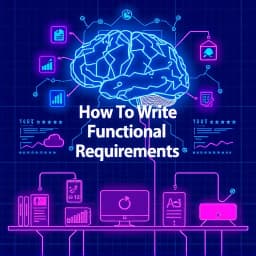
How to Write Functional Requirements
Find this useful? Bookmark ( CTRL/CMD + D ) for quick access!
Try an example:
Software Development Projects
Product Feature Specifications
User Experience Design
Agile Project Backlogs
Compliance and Regulatory Requirements
API Integration Documentation
Explore Similar Tools
Recent Generations
the amount paid directly to you. Yes it is possible in future cases to request direct payment to the provider, Rephrase and give me polished email.
we have processed the claim as per the attachments in the claim submission we have processedthe invoice for Saul Holding. We dont have invoice for the Salofalk.
this additional information is very important. this adiitional information was requested by our clinical team. Without clinical review claim not be paid so please share the below additional information
How To Write Functional Requirements
How To Write Functional Requirements is a powerful AI-powered tool designed to assist users in creating clear and concise functional requirements for software projects. This innovative solution combines advanced natural language processing with intuitive templates to deliver high-quality documentation that meets industry standards.
Key Capabilities
- Automated Requirement Generation with customizable templates to ensure consistency and clarity in documentation.
- Real-time Collaboration enabling teams to work together seamlessly, improving communication and reducing errors.
- Version Control for tracking changes and maintaining an organized history of requirements, ensuring all stakeholders are aligned.
- Integration with Project Management Tools to streamline workflows and enhance project tracking, making it easier to manage requirements throughout the development lifecycle.
Who It's For
Designed for software developers, project managers, and business analysts, How To Write Functional Requirements excels in environments where precise documentation is crucial. Whether you're drafting requirements for a new application or refining existing specifications, this tool streamlines your workflow and enhances productivity.
Why Choose How To Write Functional Requirements
What sets How To Write Functional Requirements apart is its user-friendly interface and intelligent suggestions, making it the ideal solution for teams looking to improve their documentation processes and ensure project success.
Ready to transform your requirement writing process? Start using How To Write Functional Requirements today and experience the difference in your project outcomes!
Enhance Your Work with How to Write Functional Requirements
Leverage the power of AI to streamline your tasks with our How to Write Functional Requirements tool.
Structured Requirement Templates
Access a variety of pre-defined templates to help you structure your functional requirements effectively.
Automated Validation
Ensure your requirements meet industry standards with automated checks and validations.
Collaboration Tools
Facilitate teamwork with integrated collaboration features, allowing multiple users to contribute and review requirements.
How How to Write Functional Requirements Works
Discover the simple process of using How to Write Functional Requirements to improve your workflow:
Define Scope
Begin by outlining the scope of your project and identifying the key functionalities required.
Gather Requirements
Collect detailed requirements from stakeholders to ensure all needs are addressed.
Draft Functional Requirements
Write clear and concise functional requirements based on the gathered information.
Review and Validate
Review the functional requirements with stakeholders for validation and approval.
Use Cases of
How to Write Functional Requirements
Explore the various applications of How to Write Functional Requirements in different scenarios:
Software Development
Assist software developers in creating clear and concise functional requirements for new applications, ensuring all stakeholders have a shared understanding of the project scope.
Project Management
Help project managers define and document functional requirements to facilitate better planning, resource allocation, and timeline estimation for projects.
Quality Assurance
Support quality assurance teams in developing test cases based on functional requirements, ensuring that the final product meets the specified criteria and user needs.
Stakeholder Communication
Enhance communication between stakeholders by providing a structured approach to writing functional requirements, making it easier to gather feedback and align expectations.
Who Benefits from How to Write Functional Requirements?
AI-Powered Efficiency
From individuals to large organizations, see who can leverage How to Write Functional Requirements for improved productivity:
Product Managers
Define clear and actionable functional requirements to guide product development.
Software Developers
Receive precise specifications to streamline coding and reduce misunderstandings.
Quality Assurance Teams
Ensure that all functional requirements are met through thorough testing and validation.
Stakeholders
Understand project goals and requirements to align expectations and outcomes.
Frequently Asked Questions
What are functional requirements?
Functional requirements define the specific behaviors, functions, and capabilities that a system or application must possess. They outline what the system should do, detailing inputs, outputs, and interactions.
How does the AI tool help in writing functional requirements?
The AI tool assists users by providing templates, examples, and guidance on how to articulate functional requirements clearly and concisely. It can also suggest best practices based on industry standards.
Is prior knowledge of requirements engineering necessary to use this tool?
No prior knowledge is required. The tool is designed to be user-friendly and provides step-by-step guidance, making it accessible for beginners as well as experienced professionals.
Can the tool accommodate different industries?
Yes, the tool is versatile and can be tailored to meet the needs of various industries, including software development, healthcare, finance, and more. It offers customizable templates to suit specific industry requirements.
Is there customer support available if I have questions while using the tool?
Yes, we offer comprehensive customer support through various channels, including email, chat, and phone. Our support team is ready to assist you with any questions or issues you may encounter while using the tool.
































